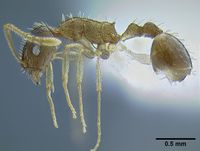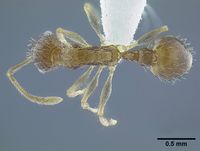Temnothorax brevidentis
| Temnothorax brevidentis | |
|---|---|

| |
| Scientific classification | |
| Kingdom: | Animalia |
| Phylum: | Arthropoda |
| Class: | Insecta |
| Order: | Hymenoptera |
| Family: | Formicidae |
| Subfamily: | Myrmicinae |
| Tribe: | Crematogastrini |
| Genus: | Temnothorax |
| Species: | T. brevidentis |
| Binomial name | |
| Temnothorax brevidentis Prebus, 2015 | |
T. brevidentis is known only from acacia woodland leaf litter at the type locality, Mpala Research Centre.
Identification
Prebus (2015) - Temnothorax brevidentis is easily distinguishable from the other Afrotropical species by the following character combination: Antennal scapes surpassing the posterior margin of the head by the length of the first funicular segment; postpetiole widest at the anterior 1/3 of the segment; setae on the posterior margin of the first gastric tergite separated by about their own length; posterior margin of head rounded; metanotal groove shallowly impressed; compound eyes moderate in size; propodeal spines short. T. brevidentis appears to be very closely related to both Temnothorax cenatus and Temnothorax rufus, differing primarily from these in having short propodeal spines.
Keys including this Species
Distribution
Distribution based on Regional Taxon Lists
Afrotropical Region: Kenya (type locality).
Distribution based on AntMaps
Distribution based on AntWeb specimens
Check data from AntWeb
Countries Occupied
| Number of countries occupied by this species based on AntWiki Regional Taxon Lists. In general, fewer countries occupied indicates a narrower range, while more countries indicates a more widespread species. |

|
Estimated Abundance
| Relative abundance based on number of AntMaps records per species (this species within the purple bar). Fewer records (to the left) indicates a less abundant/encountered species while more records (to the right) indicates more abundant/encountered species. |

|
Biology
Castes
Queens and males are unknown.
Nomenclature
The following information is derived from Barry Bolton's Online Catalogue of the Ants of the World.
- brevidentis. Temnothorax brevidentis Prebus, 2015: 30, figs. 4a, 5 (w.) KENYA.
Unless otherwise noted the text for the remainder of this section is reported from the publication that includes the original description.
Description
Worker
(n = 1). EL 0.155; FRS 0.185; HL 0.633; HW 0.479; IOD 0.422; IOcD N/A; MD 0.172; PH 0.186; PL 0.243; PPH 0.196; PPL 0.196; PPW 0.245; PTW 0.144; PW 0.355; SL 0.573; SPST 0.136; WL 0.802.
Indices: CI 75.7; DPeI 59.3; DPpI 125; LPeI 131; LPpI 100; OI 32.4; PeNI 40.6; PpNI 69; PPI 170; PSLI 21.5; SI 90.5.
Head longer than wide (CI 76); head sides parallel, but converging toward the mandibular insertions anteriorly beyond the level of the antennal insertions in full-face view; posterior head margin convex and posterior corners of head broadly rounded. Anterior clypeal margin convex and entire, with the median clypeal lobe projecting slightly beyond the lateral clypeal lobes. Frontal carinae developed: extending posteriorly about one-half the length of the compound eye. Antennae 12-segmented,antennal scapes relatively long, extending past the posterior margin of the head by the length of the first funicular segment (SI 120). Eyes moderate in size (OI 32), 8 ommatidia in longest row.
Mesosoma relatively slender (WL 1.26 times HL); promesonotal suture absent. Metanotal groove narrowly and shallowly impressed. Propodeal spines short and acute (PSLI 21.5); propodeal lobes small and rounded.
Petiole without a differentiated peduncle. In profile, the anterior face of node forming a shallow concavity anteriorly as it joins the anterior portion of the petiole. Petiolar node in profile relatively low (LPeI 131), and uniformly rounded, without distinct angles between anterior, dorsal, and posterior faces. In dorsal view petiole elongate (DPeI 59). Postpetiole in profile globular (LPpI 100) and roughly the same height as the petiole. Postpetiole in dorsal view transversely elongate-oval, widest at 1/3 of the total postpetiole length from anterior margin (DPpI 125), widest at 1/3 of the total postpetiole length from the anterior margin, and 1.7 times wider than petiole (PPI 170).
Mandibular sculpture: longitudinally striate along entire length. Clypeus smooth and shiny, bearing 9 longitudinal rugae, with median ruga strongly developed and running posteriorly from the anterior clypeal margin to the level of antennal insertions before weakening. Cephalic dorsum smooth and shining, with overlying well developed, widely spaced longitudinal rugae, which develop cross-linking rugae on the vertex. In profile, head coarsely reticulate; genae with irregular punctures anterior to the compound eye. Sculpture of mesosoma in dorsal view coarsely rugo-reticulate, with interspaces shining. Space between propodeal spines with a single well developed, arcuate transverse carina, which divides the propodeal dorsum from the declivity. Propodeal declivity irregularly shallowly punctate, bordered laterally by weak carinae which run from the ventral margins of the propodeal spines to the propodeal lobes. In profile, mesosoma predominantly finely rugo-reticulate; pronotum with coarse longitudinal rugae. Petiole and postpetiole finely punctate, with fine reticulation present on the dorsal surface of the petiolar node, and faint longitudinal rugae on the postpetiole. Gaster smooth and shining except for small, widely spaced piligerous punctures.
Head and mandibles nearly uniformly covered in a fine, yellowish pubescence. Dorsal surface of the head, including clypeus, frons and posterior margin of the head equipped with long, blunt-tipped setae. Anterior clypeal margin with two pairs of long setae flanking the median carina. Antennal scapes with short, sharp-tipped suberect pilosity. Pronotal “neck” and pronotal humeri with short, fine yellowish pubescence. Propleurae and procoxae with long, flexous, sharp-tipped pilosity. Dorsal surfaces of mesosoma, waist segments and gaster with uniformly erect, moderately long, abundant and blunt-tipped setae, their bases spaced from each other by the length of the setae or less. Bases of the setae on the posterior margin of first gastral tergite separated by about the length of the setae arising from them. Ventral surface of the gaster with sparse pilosity like that of the propleuron. Ventral surface of the post petiole free of pilosity.
Overall light reddish brown, with head and gaster slightly darker.
Type Material
Holotype worker, KENYA, Laikipia District, Mpala Research Centre, 1650 m, 0.29°N, 36.90°E, Acacia woodland, stray in litter, collection code #99-056, 24.IX.1999 (R.R. Snelling) (The Natural History Museum: CASENT0712603).
References
- Prebus, M. 2015. Palearctic elements in the old world tropics: a taxonomic revision of the ant genus Temnothorax Mayr (Hymenoptera, Formicidae) for the Afrotropical biogeographical region. ZooKeys. 483:23–57. doi:10.3897/zookeys.483.9111
References based on Global Ant Biodiversity Informatics
- Prebus M. 2015. Palearctic elements in the old world tropics: a taxonomic revision of the ant genus Temnothorax Mayr (Hymenoptera, Formicidae) for the Afrotropical biogeographical region. ZooKeys 483: 2357.

